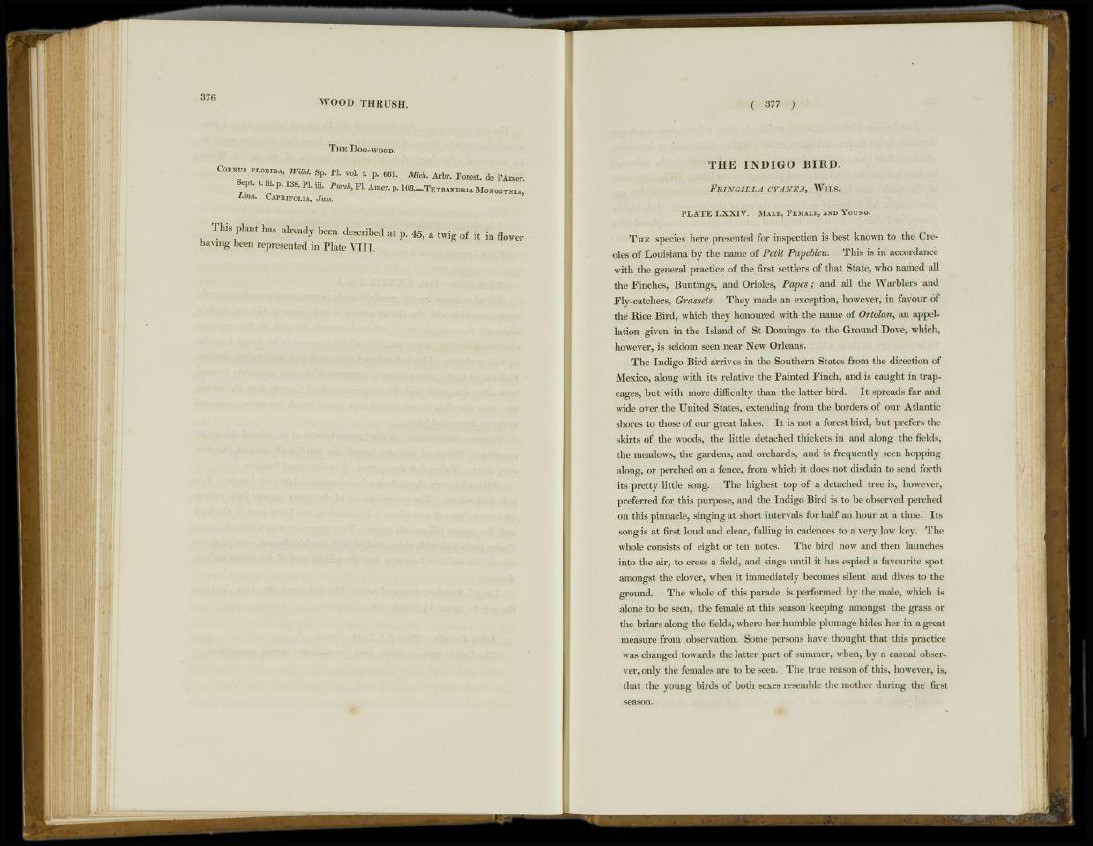
WOOD THRUSH.
THE DOG-WOOD.
C M ™ FLORIDA, WiM. Sp. PL vol. i. p. 661. Mich. Arb, Forest, de I'Ame,
Sept. t. Hi. p. 138. PL iii. Pursh, Fl. Amer. p. 108._TETRANDRIA MONOGYNIA,
I M CARRIFOLIA, JUSS.
This plant has already been described at p. 45, a twig of it in flower
having been represented in Plate VIII.
( 377 )
T H E I N D I G O BIRD.
FRINGILLA CYANEA, WILS.
P L A T E L X X I V . MALE, FEMALE, AND YOUNG.
T H E species here presented for inspection is best known to the Creoles
of Louisiana by the name of Petit Papebleu. This is in accordance
with the general practice of the first settlers of that State, who named all
the Finches, Buntings, and Orioles, Popes; and all the Warblers and
Fly-catchers, Grassets. They made an exception, however, in favour of
the Rice Bird, which they honoured with the name of Ortolan, an appellation
given in the Island of St Domingo to the Ground Dove, which,
however, is seldom seen near New Orleans.
The Indigo Bird arrives in the Southern States from the direction of
Mexico, along with its relative the Painted Finch, and is caught in trapcages,
but with more difficulty than the latter bird. It spreads far and
wide over the United States, extending from the borders of our Atlantic
shores to those of our great lakes. It is not a forest bird, but prefers the
skirts of the woods, the little detached thickets in and along the fields,
the meadows, the gardens, and orchards, and is frequently seen hopping
along, or perched on a fence, from which it does not disdain to send forth
its pretty little song. The highest top of a detached tree is, however,
preferred for this purpose, and the Indigo Bird is to be observed perched
on this pinnacle, singing at short intervals for half an hour at a time. Its
song is at first loud and clear, falling in cadences to a very low key. The
whole consists of eight or ten notes. The bird now and then launches
into the air, to cross a field, and sings until it has espied a favourite spot
amongst the clover, when it immediately becomes silent and dives to the
ground. The whole of this parade is performed by the male, which is
alone to be seen, the female at this season keeping amongst the grass or
the briars along the fields, where her humble plumage hides her in a great
measure from observation. Some persons have thought that this practice
was changed towards the latter part of summer, when, by a casual observer,
only the females are to be seen. The true reason of this, however, is,
that the young birds of both sexes resemble the mother during the first
season.